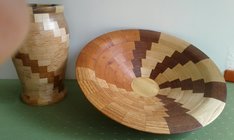I have been making segmented bowls and vases using wedges cut at 4 different angles and different number of wedges of each size (), 30(3), 221/2(4), 18(5), and 15(6) degrees(number of each). Per math friend there is over 7 million arrangements for each ring. I have found that you can get interesting patterns by mixing the wedges. Each group makes up ¼ of the ring. You can group them in any arrangements to form the rings. They make nice “Ikea” type packages to give to friends or “sa” and let them form the rings, return them when glued to their liking and then give rings back to assemble and turn the rings. Neighbor 85 years old love the doing one. I use Excel or LibreOffice Calc to calculate the wedge sizes. Here are two samples.

